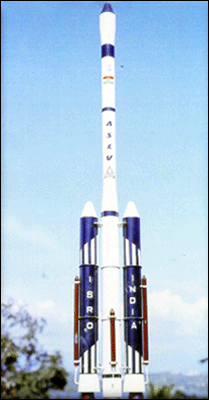AUGMENTED SATELLITE LAUNCH VEHICLE
With a takeoff weight of 40 tonnes, the 24m tall ASLV was designed as a five stage, all-solid propellant vehicle, with a mission of orbiting 150 kg class satellites into 400 km circular orbits.
The Augmented Satellite Launch Vehicle (ASLV) - Programme was designed to increase the payload capacity to 150 kg, three times that of SLV-3, for Low Earth Orbits (LEO). While construction upon the experience gained from the SLV-3 missions, ASLV proved to be a low cost intermediate vehicle to exhibit and validate critical technologies, that would be needed for the future launch vehicles like strap-on technology, inertial navigation, bulbous heat shield, vertical integration and closed loop guidance, etc.
Under the ASLV programme four development flights were conducted. The 1st developmental flight took place on March 24, 1987 and the 2nd on July 13, 1988. The 3rd developmental flight, ASLV-D3 was well launched on May 20, 1992, when SROSS-C (106 kg) was put into an orbit of 255 x 430 km. ASLV-D4, launched on May 4, 1994, orbited SROSS-C2 weighing 106 kg. It had two payloads, Gamma Ray Burst (GRB) Experiment and Retarding Potentio Analyser (RPA) and functioned for seven years.










0 comments:
Post a Comment